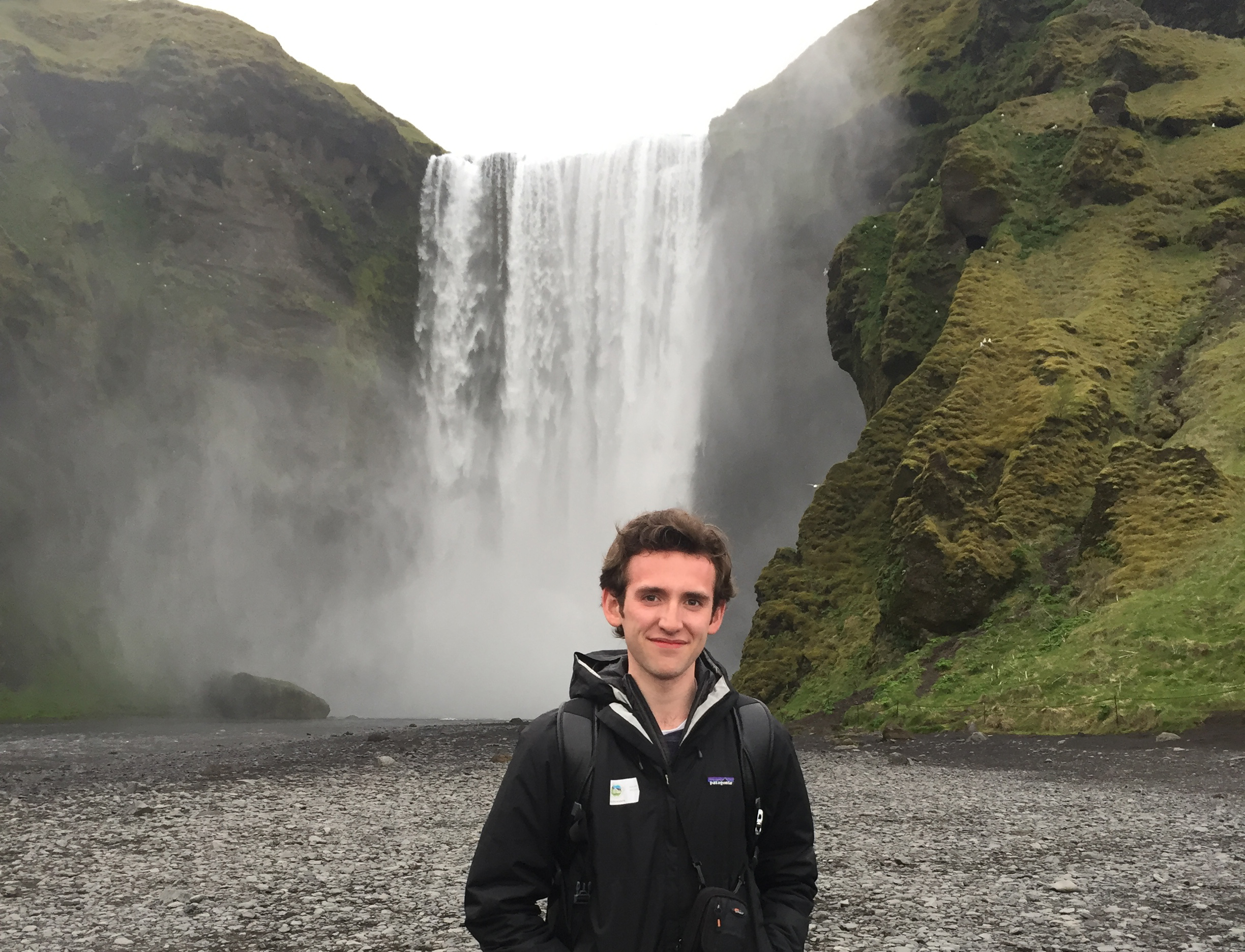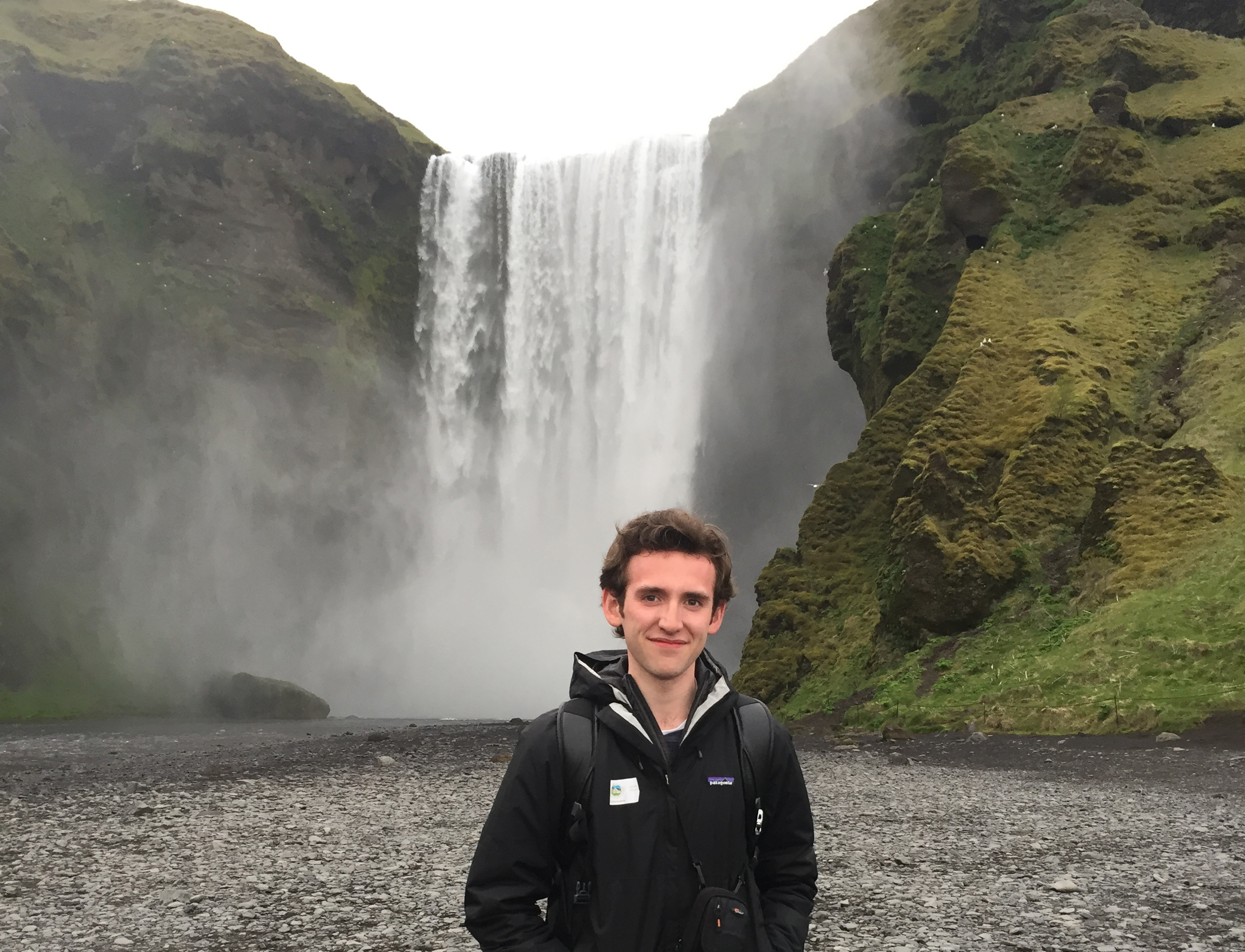Iceland: From Above
By: Joseph Squillaro, CAS ’21

Joseph standing in front of Skógafoss Waterfall in Iceland
Iceland is a place not just to be studied, but to be experienced. Through the PGS to Iceland this past Spring, I was able to do both under the lens of environmental sustainability and geology. Yet it wasn’t just the lens of the Earth and Environmental Studies Department that I was viewing Iceland from. I was also viewing this unique island from 500 feet in the air via my photography drone that made the 2,700-mile trip with me. If I could sum the purpose of my trip up in one word, it would be “perspective.”
I got the idea when in class we were discussing the vast nature of the fjords of northern Iceland near the city of Akureyri. Because these geological formations are so large, it is hard to comprehend the scope of these inlets from the ground. As a photography enthusiast along with having great experience in piloting drones, I thought this was the perfect way to show the class what we were learning from a different vantage point while also documenting the adventure we were about to go on. After checking with Penn and Iceland Air, I charged my batteries and took off to Iceland with the class and my compact DJI Spark drone in tow. On the plane, I made a map of all the places I wanted to survey along the Ring Road (Route N1) we were going to take around Iceland and with limited resources, I decided upon taking flights that highlight Iceland’s geographic wonders. These sites included: the fjords of the North, the pseudocraters of Myvatn, the windswept black sand beaches of the South and one of Iceland’s biggest waterfalls, Skogafoss (which is near the 2010 volcanic eruption of Eyjafjallajökull).
My first opportunity to fly came when the winds finally died down near the northern fjords. In class, we learned about how fjords were carved by the massive energy of retreating glaciers thousands of years ago, some of which extend miles. From our spot on the shoreline, it looked much like a bay. However, in the air, we were able to see just how far back the glaciers carved, along with a detailed view of the sentiment layers that existed in the fjord’s walls. With the sun just about to set at 11:30 PM, I filmed the setting Icelandic sun before landing for the night.
The next chance was a drizzly day around the pseudocraters of Myvatn. Despite looking like the surface of an alien planet, we learned in class that these craters were actually caused by steam explosions as hot lava crossed upon wet surfaces during Iceland’s early days. Finally finding a break in the rain, I sent up the drone to see if these geological formations looked different than the typical mounds they appear as down below. Much to the amazement of myself and my classmates, we witnessed from my flight controller’s screen that the entire area was full of these pseudocraters, each having different indentations and shapes. It was amazing to put into context the geological processes we discussed and the actual formations from the air. While atop one of these pseudocraters, I couldn’t pass up the opportunity to do a class video of us waving during a flyby. To see how small we were in comparison to Iceland’s geography and geology was a truly humbling experience!
With Iceland typically being called the island of fire and ice due to its violent volcanic eruptions surrounded by the cold ocean, the black sand beaches of Reynisfjara on the South Coast created by this dichotomy was the obvious next choice for another flight. This natural wonder, we learned, was created by molten basalt material from eruptions supercooling when contacting the sea and over time, was eroded into black sand. In addition to this, massive basalt columns line the coastline and rise up like giants standing in the sea. Curious to see more, I sent the drone up much to the bewilderment to the locals enjoying their morning stroll who likened my drone to the sound of a large mosquito. Despite fighting strong winds, the drone was able to stay level long enough to get sight of beautiful vistas of the black sands melding seamlessly with the large basalt columns that dot the shore. What was already an incredible sight below was even more incredible from above, where we could see the massive obelisks that would eventually, one day, turn into sand.

The last flight plan I had for this trip was around the Skogafoss waterfall. One of the most picturesque waterfalls in Iceland, it is also one of the largest with its large volume of water coming from the melting glacier that sits atop the volcano Eyjafjallajökull, which made headlines in 2010 for erupting and disrupting air travel between North American and Europe for months. To be there at the foot of the waterfall and witness the loud roar of the cataract was awe-inspiring. However, I wanted to see the hidden river supplying the waterfall so when the coast was clear, I sent my drone up one last time and caught breathtaking views of not only the river, but of the entire southern region of Iceland due to the day being rather free of precipitation (a rarity for Iceland). To watch the birds coalesce underneath the camera as they circled the waterfall was especially beautiful. It was a fantastic close to my drone journey.
While waiting for our flight to return to Newark Liberty International Airport, I began to reflect on the incredible things I saw from above. Not only did I have the privilege to go to Iceland and learn Icelandic environmental studies with Dr. Plante on this Penn Global Seminar, but I also saw the island’s unique landscape from a different perspective that very few get to see firsthand. Yet I also gained a different perspective from my classmates, our tour guide and the locals themselves. I am forever grateful for the perspectives I have received and cannot wait to see what other cities or places will be on my flight plan next!
PGS – Case Studies in Environmental Sustainability
Travel to Iceland
Penn Global Seminars combine intensive semester-long study with a short-term travel component that deepens your understanding of concepts discussed in the classroom. Courses options are available for Penn undergraduate students across majors and years.